-853X543.jpg)
POWERFUL PEOPLE: THE FAALTUGIRI TOUR
by Vinta Nanda March 26 2024, 12:00 am Estimated Reading Time: 7 mins, 42 secsJanhavi Samant, a force to be reckoned with, hails from the vibrant streets of Dadar, also known as the cradle of India’s cinematic heritage. Vinta Nanda introduces us to this remarkable storyteller whose journey has only just begun.
In this captivating photo-feature, we are transported to the bustling lanes teeming with crowds, each corner whispering the indelible tales of Indian cinema's rich history. Janhavi Samant, now a public relations professional, graciously guided us through the setting of her book 'Faaltugiri And Other Flashbacks', a tribute to this captivating past along with stories from her life while growing up. It was a fabulous afternoon spent by Nandita Puri, Ishan Puri, Geetika Tyagi, Siddharth Kak, Pujita Gadodia, Antara Kak and myself.
Our Faaltugiri tour commenced at the statue of Dadasaheb Phalke, the patriarch of Indian cinema. From there, Janhavi led us through a mesmerizing journey, unveiling landmarks such as Tata and Gulmohar Mills, Kumar Saloon, Bhagwan Dada's chawl, Ranjit Studio, Roop Tara studio, Mathura Bhavan, and Rehmat Terrace.
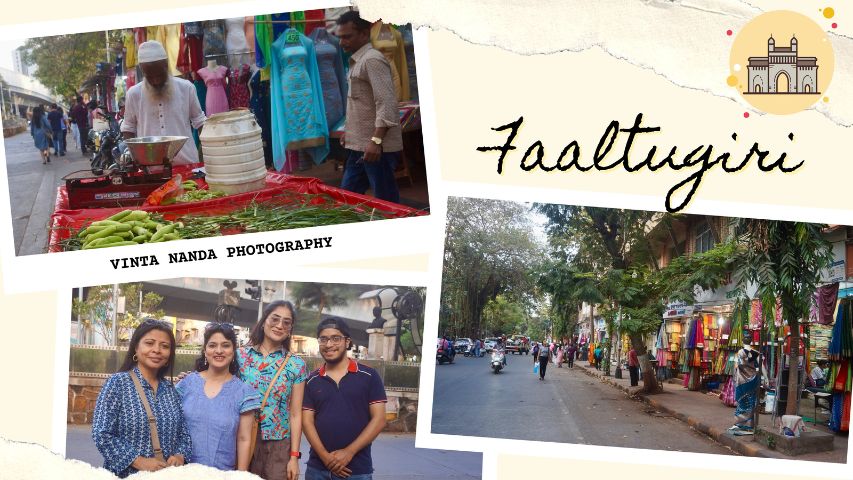
As we strolled through the lanes of Dadar, Janhavi enlightened us, "You'll notice chawls all around. In the post-independence era of the 1960s, '70s, and '80s, Mumbai's educated middle class and privileged resided in Girgaum. Conversely, the labour class inhabited Girangaon (mill village)., encompassing areas like Parel, Lal Baug, Sewri, and Wadala, where the bustling mills and factories thrived."
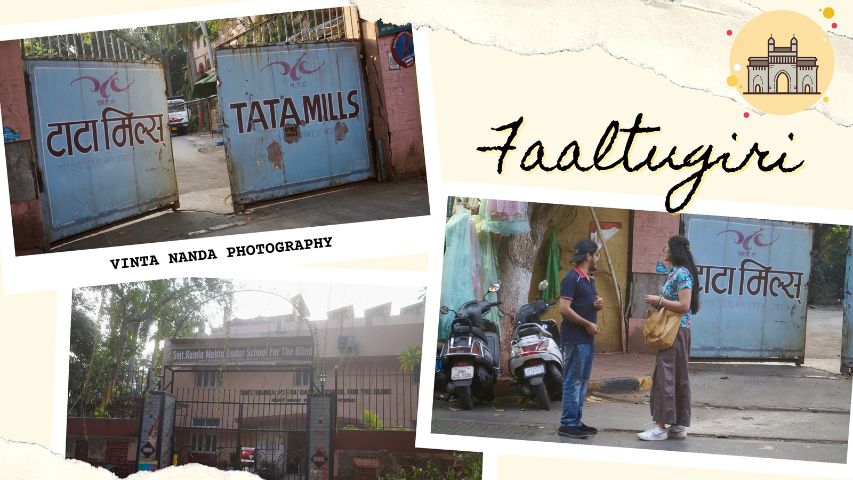
This area, where Janhavi guided us, is also known as the Mills district of Bombay. Designed with abundant recreational spaces, including gardens and maidans for children to play, the Mill District epitomized urban planning foresight. "As cinema emerged in our cultural landscape," Janhavi remarked, "the Mill District was the first to embrace it wholeheartedly. The inaugural cinema theatre in Bombay, the Elphinstone Parel Complex, stood merely 600 to 700 meters from our current location. During the 1930s, with the rise of silent films, a wave of theatres emerged in this vicinity. Directly across from us stood Hindmata, sadly, its original structure is no longer extant. Approximately a kilometre away was Bharatmata, while behind us once stood Dharti Cinema. On the main thoroughfare, there were Sharada and Chitra Cinema, and further up in Byculla was the Jaihind Theatre. It was an era suffused with nationalist sentiment, reflected even in the nomenclature of cinemas such as Bharatmata, Hindmata, and Jaihind."
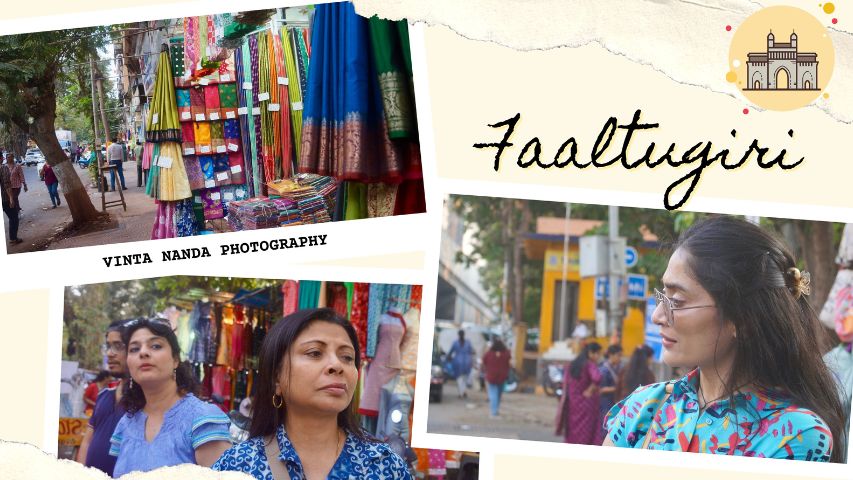
Standing at Hindmata Junction beside the statue of Dadasaheb Phalke, Janhavi shared insights into the life of the father of Indian Cinema. Dadasaheb Phalke's ground-breaking debut, "Raja Harishchandra," marked the inception of Indian cinema in 1913, now celebrated as the country's inaugural full-length feature film. Over a career spanning 19 years until 1937, Phalke crafted 95 feature-length films and 27 short films, including acclaimed works such as "Mohini Bhasmasur" (1913), "Satyavan Savitri" (1914), "Lanka Dahan" (1917), "Shri Krishna Janma" (1918), and "Kaliya Mardan" (1919). In honour of his contributions, the Government of India instituted the prestigious Dadasaheb Phalke Award, the highest honorary accolade in the National Film Awards.
Phalke's journey into the realm of cinema began with his artistic pursuits. He enrolled at the Sir J.J. School of Art, Bombay, in 1885, completing a drawing course before furthering his studies at Kala Bhavan, Faculty of Fine Arts, Maharaja Sayajirao University of Baroda, in 1886. Mastering oil and watercolour painting, as well as architecture, Phalke delved into photography, procuring a film camera in 1890. His innovative spirit earned him recognition, including a gold medal at the 1892 Industrial Exhibition of Ahmedabad for his model of an ideal theatre.
In this very lane stands Mathura Bhavan, a once-grand structure now weathered and scarcely visible from the main road, where Dadasaheb Phalke laid the groundwork for his seminal work, "Raja Harishchandra." Janhavi said, “Constructing a glass room within the compound wall, Phalke imparted his knowledge of film perforation and processing to his family. With determination, he documented the growth of a pea plant, using the footage to showcase the potential of cinema in securing funding for his debut film”.
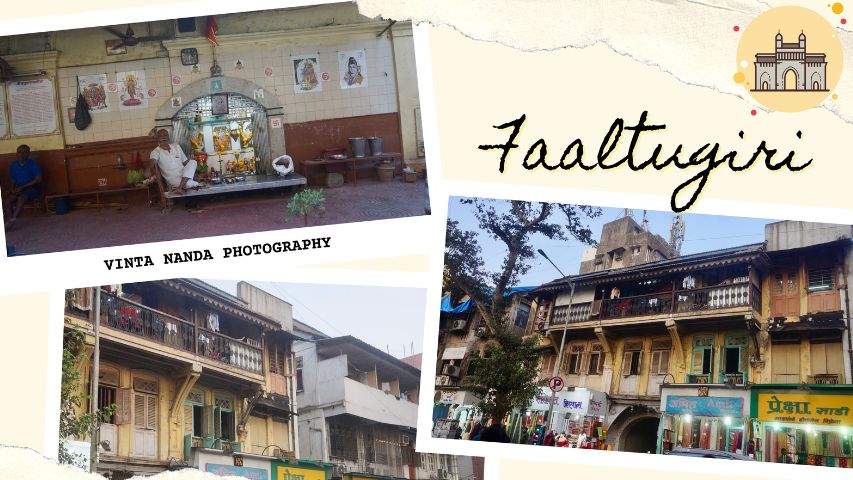
Another poignant tale associated with this lane is that of the legendary actor Meena Kumari. Geetika Tyagi listened with keen interest as Janhavi unfurled her past. Born in a nursing home in this very neighbourhood, Meena Kumari's early years were intertwined with the humble surroundings of Mithawala building, where she resided until the late 1930s. Her father, Ali Buksh, a struggling theatre artist and Urdu poet, lived in the Mithawala Chawl.
Meena Kumari's entry into the world was marked by hardship. She was the second daughter born at Dr. Gadre Clinic in Parel. Janhavi recounts, "One account suggests that her father, yearning for a son, contemplated leaving the new-born at a nearby orphanage. However, her mother intervened, insisting on bringing her back after a few days. Another narrative posits that financial constraints led her father to temporarily place her in an orphanage until he could gather the funds to settle the medical bills." Despite these challenges, her father, Ali Buksh, commenced Meena Kumari's artistic journey at the tender age of four, depriving her of a formal education and thrusting her into the world of performance.

In those bygone days, the mills were strategically situated along the railway lines for efficient transportation of materials, while the chawls were initially designed akin to hostels, featuring single rooms with communal washrooms on each floor. Over time, as workers began to bring their families to reside with them, these structures underwent internal restructuring to accommodate the evolving needs of the inhabitants.
As we ventured into the lane that once housed actor Bhagwan Dada, we were regaled with tales of his opulent lifestyle, including his possession of seven Chevrolets, affording him the luxury of utilizing a different car each day for commuting. The sight of the building and the very apartment where he dwelled filled us with fascination.
Janhavi shared intriguing anecdotes, revealing that the same lane was once home to the workshop of a renowned sculptor named Shyam Sarang. It was here that Sarang meticulously crafted all the Plaster of Paris statues for films of that era, including those featured in V. Shantaram's acclaimed movie 'Geet Gaya Patharon Ne'.

Entering Ranjit Studio evoked nostalgia for the golden era of Indian cinema. Also recognized as Ranjit Movietone, it stood as a prominent Indian film production company equipped with state-of-the-art studio facilities. Operational from 1929 until the mid-1970s, the studio was the brainchild of Chandulal Shah and Gohar Kayoum Mamajiwala. Among the triumvirate of Bollywood's largest studios during its prime were Kohinoor Film Company and Imperial Film Company.
Originally established as Ranjit Film Company, the studio embarked on silent film production in 1929, swiftly churning out 39 pictures, predominantly social dramas, by 1932. Rebranded as Ranjit Movietone in 1932, the studio soared in the 1930s, delivering a plethora of successful talkies at a prolific rate of approximately six per year. During this zenith, the studio boasted a workforce of around 300 actors, technicians, and support staff.
Among Ranjit Studio's notable successes are timeless classics such as "The Secretary" (1938), "Sati Savitri" (1932), "Gunsundari" (1934), "Barrister’s Wife" (1935), "Achhut" (1940), "Tansen" (1943), "Moorti" (1943), and "Jogan" (1950). Although its illustrious journey concluded in the late 1960s, its legacy continues to resonate within the annals of Indian cinema.
Reflecting on bygone encounters, Siddharth Kak reminisced about his rendezvous with the owners of Ranjit Studios during his tenure at Cinema Vision Magazine, predating his extensive television career as the esteemed producer and presenter of Surabhi.
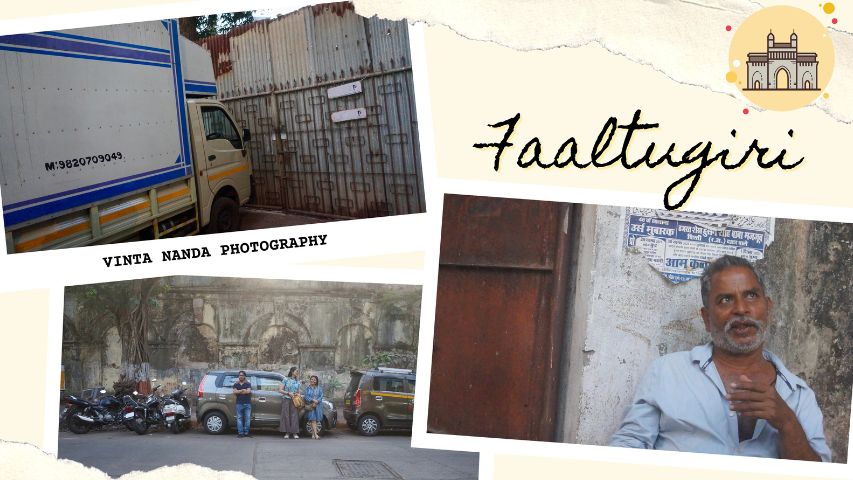
As our journey neared its conclusion, we encountered the renowned Roop Tara Studios, a once-vibrant hub now sealed off by developers who purchased and razed the property to pave the way for a towering skyscraper. The compound, once teeming with activity, lay dormant behind heavy shutters, guarded by a vigilant sentry tasked with preventing any glimpse through the gates' crevices.
Regrettably, we learned from the guard that his presence was intended to deter inquisitive passers-by. Evidently, the owner was keen to avoid any controversy surrounding the coveted plot of land that once housed a priceless gem of India's cinematic legacy.

As the day drew to a close, we eagerly made our way to Janhavi's home, where she had graciously organized drinks and an unforgettable dinner. The spread featured delectable dishes, including varan bhaat (lentils and rice), batatyachi bhaji (dry potatoes), dalimbi usal (green beans), mutton curry, adrak raita (ginger yoghurt), and sol kadhi.
But before indulging in the sumptuous feast, Nandita Puri insisted that we enjoy a tapri chai from Varsha Eknath Shinde, a spirited lady who has been serving tea at her humble stall for over thirty-five years. "Ever since my eldest boy was in the seventh standard," she recounted with immense pride.

About Janhavi’s book Faaltugiri And Other Flashbacks:
A long, long time ago, much before Hindi films were called Bollywood and Bombay was called Mumbai, before cell phones and Internet - there were kids who had no gadgets and were left most to their own devices. What was the world like for children in the ’80s? Full of faltugiri for sure! Traverse a bustling gully in Dadar with a Mumbaichi mulgi and witness her worthless attempts at cutting-edge socio-scientific experiments like collecting soap choora, pencil shavings, talcum powder, mastering the Bambaiya language and her dreams of becoming a heroine.
You can get your copy here: https://www.amazon.in/Faaltugiri-other-flashbacks-survived-childhood-ebook/dp/B07V7J3JH9





-173X130.jpg)

-173X130.jpg)
-173X130.jpg)
-173X130.jpg)
-173X130.jpg)
-173X130.jpg)